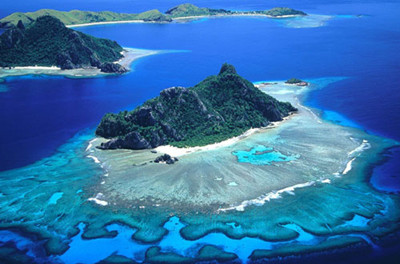This bleaching occurs because corals can only live in a narrow temperature range.
这种漂白现象之所以发生是因为珊瑚虫只能在很窄的气温范围内存活。
Healthy corals get their colour from microscopic algae living in their tissues.
健康的珊瑚虫颜色来自于生活它们组织里的海藻。
These manufacture food for the corals by photosynthesis but when the temperature rises just two degrees above the normal summer maximum, the algal cells are expelled because they no longer benefit the coral.
这些海藻通过光合作用为珊瑚虫生产食物,但是当气温上升,仅仅比夏天正常的最高气温高两度海藻细胞就会被排出,因为它们不在对珊瑚有用处。
The bleaching effect is the white chalky skeleton showing through the coral's transparent tissues.
漂白效应是珊瑚白色的骨骼,透过透明的组织显露出来。
But they're not dead. Not yet.
但是它们没有死亡。
They can survive in this bleached state for several weeks.
它们能在这种漂白状态下生存几个星期。
If the temperature drops,the corals acquire new algae from plankton floating by.
如果气温下降,珊瑚从游过的浮游生物获得新的海藻。
But, if the warm water persists, the coral dies.
但是如果水温继续保持下去,珊瑚就会死亡。
Coral bleaching hadn't been seen on the Great Barrier Reef before the 1980s.
在大堡礁珊瑚礁变白现象在19世纪80年代之前,没有被看到过。
Due to global warming, bleaching's now more common and cyclones are likely to be more frequent too.
由于全球变暖,珊瑚礁变白变得更普遍,飓风也变得更频繁了。
And there's something even more insidious.
有一些事情有着更严重的潜在危险。
Temperatures are rising because more and more carbon dioxide from human activity enters the atmosphere.
气温上升是由于人类活动导致越来越多的,二氧化碳进入到大气。
This dissolves in seawater turning it weakly acidic,which can stop coral growth.
它们溶解到海水中导致海水轻微变酸,这能导致珊瑚礁停止生长。
If they can't build their chalky skeletons,reefs will start to crumble.
如果它们不能建造它们的骨骼,珊瑚礁将会开始慢慢垮掉。
译文属可可原创,仅供学习交流使用,未经许可请勿转载




